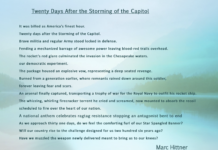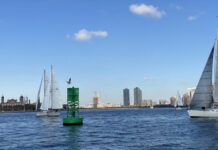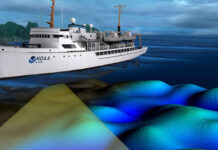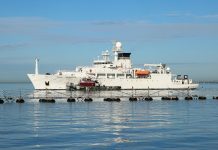The motto, ‘Save the Whales’ is a cry of hope for the preservation of ocean mammals everywhere on the planet. Closer to home, for those who make a living from New York Harbor or those who simply love recreation around it, we are keenly aware of the importance of sustaining ocean marine life. In light of recent developments from the Trump White House, no doubt, we are at the turning point.
WHALE SIGHTINGS IN AND AROUND NEW YORK HARBOR
In 2014, more than one hundred Humpback whales were spotted near the entrance of New York Harbor. Although spottings of that magnitude have not occurred since then, we know the whales are here. On June 23rd, 2016, a Digital Acoustic Monitoring Instrument (DMON), was mounted on the New York Bight Buoy nicknamed ‘Melville’, twenty-two miles south of Fire Island. The real-time Iridium satellite began transmitting data directly to the Woods Hole Oceanographic Institute Biology Department. Within twelve days, the program detected the vocalization of a Fin whale. Fin whales generally measure seventy feet in length and weigh seventy tons. They are the second largest whale species after the Blue Whale. Five months later, a whale was spotted near the Statue of Liberty.
ABC7 NY Report: Whale Spotted in NY Harbor
Dr. Howard Rosenbaum, the Director of the Wildlife Conservation Society’s Ocean Giants Program at the New York Aquarium and one of the team responsible for the implementation of the New York Bight buoy, could only guess it was a Humpback as the Humpbacks were detected by the buoy earlier that week. “We have some of the largest animals on the planet in our own backyard.” Rosenbaum said. “It’s a reawakening to New Yorkers of all the amazing marine life in our waters.” Adult humpbacks generally measure fifty feet in length and weigh thirty tons.
Humpback whale singing: – Sped up 4x
The New York Bight buoy offers real-time data of whale activity, minute by minute. Mark Baumgarten is in charge of the Woods Hole DMON program. His crew reads spectrogram graphs that are dissected to visually identify whale vocalization that is hidden in the blanket of noise created by passing ships. The mission of Dr. Rosenbaum and Mr. Baumgarten’s buoy is to provide a simple tool for sea captains to use in the shipping channels in and out of New York Harbor.
THE UNDERWATER GEOLOGIC HOTSPOT CALLED THE HUDSON CANYON
Ten thousand years ago, the Hudson Canyon was formed by the last Ice Age that shaped North America. The underwater canyon runs parallel to the New Jersey coastline. It is sixty miles long and seven miles wide with walls that are almost a mile deep. Marine scientists describe the canyon and the expansive valley shelf as a biodiversity hot spot. Over the centuries, ocean mammals followed the canyon as a major migratory route.
THE NORTH ATLANTIC RIGHT WHALE IS AN ENDANGERED SPECIES
It cannot be disputed that human exploits and resulting pollution along the eastern seaboard is directly responsible for diminished whale numbers. What is worse, whale calving is not repopulating their species to acceptable numbers. Recent evidence shows there have been no new calves born in 2018 and current data indicates a population of the North Atlantic Right whales might be as few as 350 individuals. North Atlantic Right whales are generally fifty feet long and weigh seventy tons. These baleen whales are of the genus, Eubalaena Glacialis, translated to the ‘True Whales of Ice’.
Right Whale “Upcall”: – Sped up 2x
During the Obama Presidency, the National Oceanic and Atmospheric Administration (NOAA), officially stated the Greater Atlantic Region must develop quality-controlled conservation efforts to help save the Right Whales. However, federal agencies are no longer making such public statements in the present Administration. In fact, the White House has mandated review of NOAA’s Technical Memorandum of July 2016 “Technical Guidance for Assessing the Effects of Anthropogenic Sound on Marine Mammal Hearing.”
THE REGION ALONG THE U.S. EASTERN SEABOARD IS KNOWN AS THE ‘CRITICAL HABITAT’
There are two zones that make up the Critical Habitat Primary areas off the Eastern coastline. One is Cape Cod, Massachusetts. The other is the span between Savannah, Georgia and Cape Canaveral, Florida. These two seasonal zones are where whales most commonly are found calving. It is also where they surface to find and filter their food. Unfortunately, fishing net entanglement, plastic pollution, ship strikes, and noise pollution are also found here.
NOISE POLLUTION KILLS WHALES
The oceangoing vessels that arrive and depart New York Harbor must be aware of how the the sound of their ships affect migratory whales in the Atlantic Ocean. Ocean mammals try desperately to escape the disturbing noise and have exhibited unusual, dramatic behavioral change to avoid the excessive noise. Whales washed up on beaches have been autopsied and scientists found the blood in their brains came from their ears. Other beached whales had air bubbles in their lungs. This is similar to symptoms characteristic of the bends when human divers surface too quickly.
Ships produce noise frequency that is the same level that many ocean mammals use to communicate. See for yourself how many ships become a source of noise contamination. Open the AIS marine tracking maps found here on our website. Dozens of ships pass over the areas where the migratory whales either travel or feed. Ocean vessel noise is not limited to the local waters they travel through. The ocean serves as a mega-amplifier.
SOUND TRAVELS GREAT DISTANCES.
Many factors affect underwater noise pollution. The constant pings of echolocation used by fishing boats to find fish, cavitation from propellers that creates tiny bubbles that pop like bubblewrap, and vibration of ship machinery, all range in sound produced underwater similar to a room vacuum cleaner to that of a jet engine. Marine scientists have a responsibility to offer precise information to verify these facts. Tagging is often not an option.
A NATURAL BIOLOGICAL DATA COLLECTION TECHNIQUE
As physical data collection from active whales is near to impossible, an alternative method was required. During their study of ship noise, New England Aquarium researchers needed to discover the easiest way to measure the bacteria levels and stress hormones of Right whales off Cape Cod. The scientists trained dogs to pick up the scent of whale fecies or scat. Laboratory analysis of scat has proved invaluable.
Scientists have been tracking ship noise for many years to measure their detrimental effects on ocean mammals. Ironically, the entire week after the World Trade Towers attack of September 11th, 2001, had a drastic reduction in commercial ship traffic in the Atlantic shipping lanes. Not coincidental, New England Aquarium researchers found the biological stress levels taken that same week were noticeably reduced in the collected samples as well. These studies offer conclusive evidence that ship noise is definitely a factor.
The alarming decrease in the Right Whale population created public forums that encouraged the commercial shipping industry to comply with simple common sense approaches to reduce noise. Newer ships are equipped with more efficient, less noisy, propellers.
Decades past, acoustic buoys and hydrophones were deployed in hopes there frequencies would help move whales out of the shipping channels. But the researchers found the whales were attracted to the buoy signals. Unfortunately, whales are forced to live in an ocean environment where they have lost close to ninety percent of their acoustic habitat. This affects a whale’s ability to find a mate, eat, and migrate.
So, the marine scientific community has one request to sea captains… “Slow Down!”
Link to the N Y Bight Buoy Readings and Recordings.
EFFECTS OF PRESIDENT TRUMP’S EXECUTIVE ORDER
On April 28th, 2017, President Trump signed an Executive Order called the America First Offshore Energy Strategy. As the department deputy secretary under Ryan Zinke, Bernhardt had the qualifications, ability and desire to overturn existing Obama-era policies to open protected waters to new mining and drilling efforts. According to a fact sheet on Trump’s executive order, “Past administrations have been overly restrictive of offshore energy exploration and have taken off the table hundreds of millions of offshore acres for development.”
The order called for a new five year program authorizes revisiting the ‘Outer Continental Shelf Planning Areas’. (OCSLA 1953 Act). The Bureau of Ocean Energy Management (BOEM) operating within the Department of the Interior, reported “the Outer Continental Shelf (OCS) contains 90 billion barrels of undiscovered technically recoverable oil and 327 trillion cubic feet of recoverable technically recoverable natural gas.” In the past, BOEM had previously denied permits to the gas and oil industry “based on the risks to marine life outweighing the value of any information to be gleaned from the surveys”.
The Trump Administration openly instructed the Interior Department to weaken safety regulations on offshore drilling. Additionally, “The Secretary of the Interior will work with the Department of Commerce and to the maximum extent permitted by law, develop a streamlined permitting approach for privately funded seismic data research and collection aimed at expeditiously determining the offshore energy resource potential of the United States.”
NOAA’S NOVEMBER 30TH, 2018 ANNOUNCEMENT
[CGG PHOTO]
AN EAST COAST COLLABORATIVE EFFORT TO STOP SEISMIC BLASTING
This past December 7th, 2018, led by the Boston based New England Aquarium, a collaborative effort of all aquariums, marine conservation organizations, Congressional leaders, and all but two Governors of states along the Eastern Seaboard, have advocated on the side of a reasonable and responsible global initiative. “To introduce the additional major and possibly lethal stressor of seismic blasting to already beleaguered whale populations along the Atlantic seaboard is an abdication of NOAA’S responsibility for the sound management of living marine resource in the region.”
In a conference call, Donna Wieting, director of NOAA’s Fisheries Office of Protected Resources, said her department had done “a very thorough job” in reviewing public comments and responding to them. Wieting reiterated that companies utilizing seismic blasting will adhere to a 56 mile radius rule to protect endangered species and NOAA observers will be aboard the vessels conducting the data collection. Ironically, NOAA states the air guns are more environmentally friendly than using explosives.
A LEGAL RESCUE
A letter from Senator Charles Schumer to New York Harbor Channel dated February 5th, 2019 states, “Despite the incredible ecological significance of our oceans, proposals continue to be introduced by Congress and the administration to open them up to damaging oil and gas drilling, which I oppose. Instead of spoiling our precious resources, I believe the government needs to protect this area for future generations.” Two of the bills that Senator Schumer refers to are a) the Streamlining Environmental Approvals (SEA) Act; and b) the Strengthening the Economy with Critical Untapped Resources to Expand American Energy (SECURE) Act. Both of these bills have passed in the House Natural Resources Committee and both are designed to override and strip important protections to the existing Endangered Species Act. Schumer’s camp supports efforts to pass additional federal protections such as the Atlantic Seismic Airgun Protection Act.
Maryland’s Attorney General, Brian Frosh, declared, “The Trump Administration’s grant of these authorizations is misguided and unlawful. In opening the door to harassment of tens of thousands of marine mammals, including endangered species, the administration has again placed the interests of the fossil fuel industry ahead of our irreplaceable natural resources.”
Several Environmental groups filed a law suit on December 11th in South Carolina to stop the seismic blasting based on the claim that the blasts would violate the Marine Mammal Protection Act.
WHAT IS NEXT?
Subscribe here to New York Harbor Channel and you will be updated on the latest news, developments. events, and initiatives that are local, regional, or global. As events unfold, NYHC will identify the location of research vessels using our Marine GPS Tracking Maps.
Sadly, it is apparent dozens of Marine Environmental groups will now need to actively support independent tracking and physical observation of government regulated programs. No doubt, concerned citizens will want to know the latest movements of NOAA, BOEM, and DOI.
WHAT CAN NEW YORKERS DO RIGHT HERE IN OUR OWN WATERS?
Locally, New Yorkers need to support the success of the Rockaway Artificial Reef. Growth of this submerged area in the New York Bight will create a biodiversity and attract whales to our region. Of course, common sense initiatives must guide our better judgment. We must prepare for the visits of these ocean giants. Do we know how to treat them once they grace us with their presence? Let’s embrace the teachings of the marine biology experts and share our experiences on public forums.
MAY 11TH, 2019 PROGRAM AT BROOKLYN’S 69TH STREET PIER
New York Harbor Channel will host a program to discuss the importance of tracking marine mammals. Specifically, we will have live interactive tracking of the New York Bight buoy with guest speakers involved in marine mammal preservation. Local High School students interested in marine biology will offer their personal commentary and studies of marine life in and around New York Harbor. The program will run from 11am to 1pm. Click here for directions to the event by South Brooklyn Ferry as well as bus and subway.
In the coming months, New York Harbor Channel will communicate with sea captains who have successfully avoided contact with whales. Their stories will be recorded here on our site. ‘Save The Whales’ must be a call to all of us. Meanwhile, we wait to witness a whale breach outside of New York Harbor with joyous expectation.
AD:
Custom progamming, database and system support
Best custom computer programming, database and system work. https://custom-software-usa.com Custom Software USA













